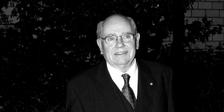Ulrich Bonse in 2018 (Photo: J. Huhn//TU Dortmund)
Professor Ulrich Bonse, a much-valued expert in the fields of X-ray physics and the development of novel experimental methods, passed away in October 2022 at the age of 94 years. We bid farewell in mourning and with gratitude from an outstanding scientist and personality who was very important for the development of X-ray photon science at DESY.
Ulrich Bonse was a highly appreciated teacher and colleague and created a very successful school of X-ray sciences at the University of Dortmund (now: TU Dortmund). Together with his students, he pioneered the usage of synchrotron radiation for condensed matter research at the DESY electron/positron storage rings, large-scale facilities originally built by the particle physics communities for colliding beam experiments where beam stability is crucial only at the interaction points. In contrast, particle beam instabilities in the bends of the ring cause shifts of the position of the synchrotron radiation beam at the sample location and can miss it easily. For this reason, simultaneous operation of the two types of experiments could not work and Ulrich Bonse together with the German synchrotron radiation community campaigned for an increasing share of dedicated beamtime at the DORIS storage ring, the establishment of HASYLAB for improving user support and the construction of the bypass including six insertion devices. Finally, DORIS III became a dedicated synchrotron radiation facility in 1993.
During the first years, the activities of Ulrich Bonse’s group at DESY were focused on the construction of beamlines, especially on design and construction of novel monochromator systems. Handling of the extreme beam intensities, rejection of higher harmonics and focusing of the beam to sub-millimeter cross sections were among the biggest challenges, beam instabilities were the biggest hurdle. The Bonse group supported less experienced users very generously with advice and helped with providing access to the crystal preparation laboratory at their home institute in Dortmund.
Instruments like the two-crystal diffractometer installed at the DORIS III beamline G3 were always further improved by his group to make best use of the available synchrotron source. In particular, all advancements of phase contrast imaging techniques over the last decades now enable the visualisation of biomedical samples with unprecedented resolution. Before and even after his retirement in 1993, Ulrich Bonse has shaped the field of research of X-ray computed tomography (CT) with synchrotron radiation.
Ulrich Bonse engaged himself passionately in the construction of the European Synchrotron Radiation Facility ESRF, the first low-emittance, high-energy storage ring operated exclusively with undulator X-ray sources. He would have loved to get it constructed in Dortmund. Nevertheless, after the site selection for Grenoble was made, Ulrich Bonse served in various advisory committees and helped the ESRF to become the best synchrotron radiation facility worldwide.
Professor Ulrich Bonse will remain a role model for many scientists.
Obituary from: Jochen R. Schneider (DESY Photon Science Research Director emeritus)






